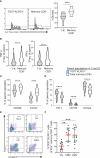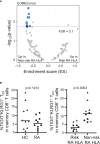Abatacept increases T cell exhaustion in early RA individuals who carry HLA risk alleles
- PMID: 38650930
- PMCID: PMC11033422
- DOI: 10.3389/fimmu.2024.1383110
Abatacept increases T cell exhaustion in early RA individuals who carry HLA risk alleles
Abstract
Exhausted CD8 T cells (TEX) are associated with worse outcome in cancer yet better outcome in autoimmunity. Building on our past findings of increased TIGIT+KLRG1+ TEX with teplizumab therapy in type 1 diabetes (T1D), in the absence of treatment we found that the frequency of TIGIT+KLRG1+ TEX is stable within an individual but differs across individuals in both T1D and healthy control (HC) cohorts. This TIGIT+KLRG1+ CD8 TEX population shares an exhaustion-associated EOMES gene signature in HC, T1D, rheumatoid arthritis (RA), and cancer subjects, expresses multiple inhibitory receptors, and is hyporesponsive in vitro, together suggesting co-expression of TIGIT and KLRG1 may broadly define human peripheral exhausted cells. In HC and RA subjects, lower levels of EOMES transcriptional modules and frequency of TIGIT+KLRG1+ TEX were associated with RA HLA risk alleles (DR0401, 0404, 0405, 0408, 1001) even when considering disease status and cytomegalovirus (CMV) seropositivity. Moreover, the frequency of TIGIT+KLRG1+ TEX was significantly increased in RA HLA risk but not non-risk subjects treated with abatacept (CTLA4Ig). The DR4 association and selective modulation with abatacept suggests that therapeutic modulation of TEX may be more effective in DR4 subjects and TEX may be indirectly influenced by cellular interactions that are blocked by abatacept.
Keywords: HLA risk alleles; T cell exhaustion; abatacept; autoimmunity; rheumatoid arthritis.
Copyright © 2024 Long, Muir, Jones, Wall, Ylescupidez, Hocking, Pribitzer, Thorpe, Fuchs, Wiedeman, Tatum, Lambert, Uchtenhagen, Speake, Ng, Heubeck, Torgerson, Savage, Maldonado, Ray, Khaychuk, Liu, Linsley and Buckner.
Conflict of interest statement
SL has past and current research projects sponsored by Janssen and SonomaBio. She is a member of the Type 1 Diabetes TrialNet Study Group. VM is currently employed by The Janssen Pharmaceutical Companies of Johnson & Johnson. HU is currently employed by Anocca AB. VW is currently employed by Notch Therapeutics. JT is currently employed by Bristol Myers Squibb. PL is a consultant for Link Therapeutics. JB is a Scientific Co-Founder and Scientific Advisory Board member of GentiBio, a consultant for Bristol Myers Squibb, Neoleukin Therapeutics and Hotspot Therapeutics, and has past and current research projects sponsored by Amgen, Bristol Myers Squibb, Janssen, Novo Nordisk, and Pfizer. She is a member of the Type 1 Diabetes TrialNet Study Group, a partner of the Allen Institute for Immunology, and a member of the Scientific Advisory Boards for the La Jolla Institute for Allergy and Immunology, Oklahoma Medical Research Foundation, and BMS Immunology. JB also has a patent for tenascin-C autoantigenic epitopes in rheumatoid arthritis. The remaining authors declare that the research was conducted in the absence of any commercial or financial relationships that could be construed as a potential conflict of interest. The author(s) declared that they were an editorial board member of Frontiers, at the time of submission. This had no impact on the peer review process and the final decision.
Figures





Similar articles
-
An atlas of immune cell exhaustion in HIV-infected individuals revealed by single-cell transcriptomics.Emerg Microbes Infect. 2020 Dec;9(1):2333-2347. doi: 10.1080/22221751.2020.1826361. Emerg Microbes Infect. 2020. PMID: 32954948 Free PMC article.
-
Delayed Expression of PD-1 and TIGIT on HIV-Specific CD8 T Cells in Untreated HLA-B*57:01 Individuals Followed from Early Infection.J Virol. 2020 Jul 1;94(14):e02128-19. doi: 10.1128/JVI.02128-19. Print 2020 Jul 1. J Virol. 2020. PMID: 32350076 Free PMC article. Clinical Trial.
-
Expression of IL-7Rα and KLRG1 defines functionally distinct CD8+ T-cell populations in humans.Eur J Immunol. 2019 May;49(5):694-708. doi: 10.1002/eji.201847897. Epub 2019 Mar 25. Eur J Immunol. 2019. PMID: 30883723 Free PMC article.
-
Human leukocyte antigen polymorphisms and personalized medicine for rheumatoid arthritis.J Hum Genet. 2015 Nov;60(11):691-6. doi: 10.1038/jhg.2015.36. Epub 2015 Apr 23. J Hum Genet. 2015. PMID: 25903069 Review.
-
Abatacept for the treatment of rheumatoid arthritis.Expert Rev Clin Immunol. 2019 Apr;15(4):319-326. doi: 10.1080/1744666X.2019.1579642. Epub 2019 Feb 18. Expert Rev Clin Immunol. 2019. PMID: 30730220 Review.
Cited by
-
Changes in NK Cells and Exhausted Th Cell Phenotype in RA Patients Treated with Janus Kinase Inhibitors: Implications for Adverse Effects.Int J Mol Sci. 2025 May 28;26(11):5160. doi: 10.3390/ijms26115160. Int J Mol Sci. 2025. PMID: 40507968 Free PMC article.
-
Inflammatory Pathways to Carcinogenesis: Deciphering the Rheumatoid Arthritis-Lung Cancer Connection.Cancers (Basel). 2025 Apr 15;17(8):1330. doi: 10.3390/cancers17081330. Cancers (Basel). 2025. PMID: 40282506 Free PMC article. Review.
References
-
- Beltra JC, Manne S, Abdel-Hakeem MS, Kurachi M, Giles JR, Chen Z, et al. . Developmental relationships of four exhausted CD8(+) T cell subsets reveals underlying transcriptional and epigenetic landscape control mechanisms. Immunity. (2020) 52:825–41 e8. doi: 10.1016/j.immuni.2020.04.014 - DOI - PMC - PubMed
Publication types
MeSH terms
Substances
Grants and funding
LinkOut - more resources
Full Text Sources
Medical
Molecular Biology Databases
Research Materials
Miscellaneous

